The aluminium profiles for the solar panel market are expected to grow to USD 4,596.3 million in 2025 and expand to USD 6,237.2 million by 2035, registering a compound annual growth rate (CAGR) of 3.1% over the forecast period. This steady growth reflects the increasing adoption of aluminium framing solutions in solar panel manufacturing, driven by their durability, lightweight nature, and corrosion resistance. Rising investments in renewable energy infrastructure globally, along with supportive government policies for clean energy, are key catalysts for growth. The market’s expansion demonstrates a consistent focus on enhancing solar panel efficiency and longevity, while optimizing production costs. As solar energy becomes an integral part of the global energy transition, aluminium profiles remain critical for sustainable and scalable solar installations across residential, commercial, and utility-scale projects.
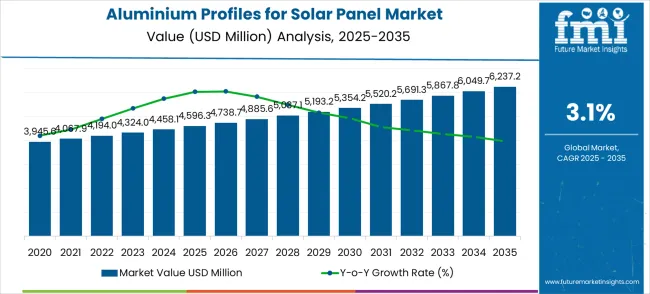
| Metric | Value |
|---|---|
| Estimated Value in (2025E) | USD 4,596.3 million |
| Forecast Value in (2035F) | USD 6,237.2 million |
| Forecast CAGR (2025 to 2035) | 3.1% |
One of the main factors driving the market is the growing emphasis on structural efficiency and long-term performance of solar panels. The year-on-year growth trend shows a gradual upward trajectory, with market values increasing from USD 3,945.6 million in 2023 to USD 4,596.3 million in 2025, continuing to rise steadily over the subsequent decade. Aluminium profiles offer lightweight yet strong support for solar panels, reducing installation costs and improving durability against environmental factors such as wind and corrosion. Collaborations between profile manufacturers and solar module producers are also accelerating the adoption of solar energy. Advancements in extrusion and coating technologies enable tailored solutions for diverse solar projects, reinforcing the market’s resilience and attractiveness for long-term investments in renewable energy infrastructure.
The market is expected to maintain a steady growth pattern, with market values reaching USD 5,354.2 million by 2030 and eventually USD 6,237.2 million by 2035, reflecting a moderate CAGR of 3.1%. The consistent year-on-year increase highlights the expanding use of aluminium framing across residential rooftops, commercial facilities, and utility-scale solar farms. As solar installations continue to grow worldwide, the demand for high-quality, durable, and cost-effective aluminium profiles will rise correspondingly. Technological advancements in profile design, recycling, and lightweight construction will further boost adoption. The market outlook indicates a sustained emphasis on renewable energy infrastructure, with aluminium profiles playing and crucial role in supporting efficient and long-lasting solar panel systems.
Market expansion is being supported by the increasing global demand for renewable energy solutions and the corresponding shift toward durable structural materials that can provide superior corrosion resistance while meeting industry requirements for lightweight and cost-effective solar mounting systems. Modern solar manufacturers and installation companies are increasingly focused on incorporating aluminium profiles to enhance system longevity while satisfying demands for reduced installation complexity and improved structural performance. Aluminium profiles' proven ability to deliver superior weather resistance, structural strength, and recyclability makes them essential materials for solar panel mounting, framing, and structural support applications.
The growing emphasis on sustainable energy transition and green building practices is driving demand for high-quality aluminium profile products that can support distinctive structural capabilities and premium solar system positioning across utility-scale installations, commercial rooftops, and residential applications. Manufacturer preference for materials that combine structural excellence with environmental sustainability is creating opportunities for innovative aluminium profile implementations in both traditional solar installations and emerging floating solar and agrivoltaic applications. The rising influence of circular economy principles and material lifecycle considerations is also contributing to increased adoption of premium aluminium profile products that can provide authentic sustainable construction characteristics.
The aluminium profiles for the solar panel market represent a mature, steady-growth opportunity within the renewable energy supply chain, with the market projected to grow from USD 4,596.3 million in 2025 to USD 6,237.2 million by 2035 at a modest 3.1% CAGR. This 35.7% expansion reflects the established nature of this essential but commoditized component market serving the solar industry's structural needs.
This market provides the critical mounting, framing, and structural support systems that enable solar panel installations across all segments, from residential rooftops to utility-scale ground-mounted facilities. The 3XXX series alloy leads with 34.7% market share due to its optimal balance of corrosion resistance, formability, and cost-effectiveness. At the same time, ground-mounted PV power plants dominate applications given the massive scale of utility solar deployments. Geographic growth is highest in China (4.2% CAGR), driven by solar manufacturing leadership, though overall market expansion remains constrained by aluminum price volatility and competition from alternative materials.
Pathway A - Ground-Mounted Utility Solar Infrastructure. The dominant application segment serves the rapidly expanding utility-scale solar market, requiring massive quantities of structural components. Companies developing cost-effective, high-volume production capabilities for utility solar mounting systems will capture this primary market segment, driving overall industry demand. Expected revenue pool: USD 2,500-3,200 million.
Pathway B - 3XXX Series Alloy Optimization. The leading alloy category offers the optimal performance-to-cost ratio for most solar applications. Providers developing enhanced 3XXX series formulations with improved corrosion resistance, strength characteristics, and manufacturing efficiency will maintain leadership in this established market segment. Opportunity: USD 1,800-2,400 million.
Pathway C - Commercial and Industrial Rooftop Systems. Growing distributed solar adoption on commercial buildings creates opportunities for specialized mounting solutions. Developing lightweight, easy-to-install profile systems optimized for rooftop applications addresses this expanding market segment with potentially higher margins than utility-scale projects. Revenue uplift: USD 1,200-1,800 million.
Pathway D - Geographic Expansion in High-Growth Markets. China and India's acceleration in solar deployment create substantial volume opportunities. Local manufacturing capabilities, competitive pricing strategies, and proximity to major solar installation markets enable capture of these highest-growth regional opportunities, driving global demand. Pool: USD 1,500-2,200 million.
Pathway E - Circular Economy and Recycling Solutions. Environmental regulations and sustainability requirements drive demand for recycled aluminum content and end-of-life recycling capabilities. Developing sustainable production processes with high recycled content and closed-loop recycling systems addresses growing environmental requirements while potentially reducing material costs. Expected upside: USD 800-1,300 million.
Pathway F - Specialized Applications and Emerging Technologies. Floating solar, agrivoltaics, and building-integrated photovoltaics require specialized mounting solutions. Companies developing innovative profile systems for these emerging applications can capture premium pricing and market differentiation beyond traditional ground-mounted and rooftop installations. USD 600-1,000 million.
Pathway G - Advanced Alloy Development. High-performance applications requiring superior strength, corrosion resistance, or specialized properties create opportunities for premium alloy systems. Developing advanced 5XXX, 6XXX, or 7XXX series profiles for demanding applications enables premium pricing and market differentiation, allowing for increased revenue and market share. Pool: USD 500-900 million.
Pathway H - Integrated Solar Solutions and Value-Added Services. Beyond basic profiles, offering complete mounting system solutions, engineering services, and installation support creates customer stickiness and higher margins. Developing comprehensive solar structural solutions, along with technical support and customization services, differentiates us from commodity aluminum suppliers. Expected revenue: USD 400-700 million.
The market is segmented by alloy series, application, and region. By alloy series, the market is divided into 3XXX series, 5XXX series, 6XXX series, and 7XXX series. Based on application, the market is categorized into ground-mounted PV power plants, commercial & industrial rooftop PV systems, and residential rooftop PV systems. Regionally, the market is divided into North America, Europe, East Asia, South Asia & Pacific, Latin America, and the Middle East & Africa.
The 3XXX series segment is projected to account for 34.7% of the aluminium profiles for the solar panel market in 2025, reaffirming its position as the leading alloy series category. Solar manufacturers and installation companies increasingly utilize 3XXX series aluminium profiles for their superior corrosion resistance, excellent formability, and cost-effective properties across diverse solar mounting applications. 3XXX series alloy technology's balanced performance characteristics and reliable processing directly address the industry requirements for durable solar components and efficient manufacturing processes in commercial solar production operations.
This alloy series segment forms the foundation of modern solar mounting applications, as it represents the material with the greatest application versatility and established manufacturing compatibility across multiple solar installation systems. Manufacturer investments in 3XXX series alloy optimization and profile enhancement continue to strengthen adoption among solar component producers. With solar companies prioritizing durability and cost-effectiveness, 3XXX series aluminium profiles align with both performance objectives and economic requirements, making them the central component of comprehensive solar mounting strategies.
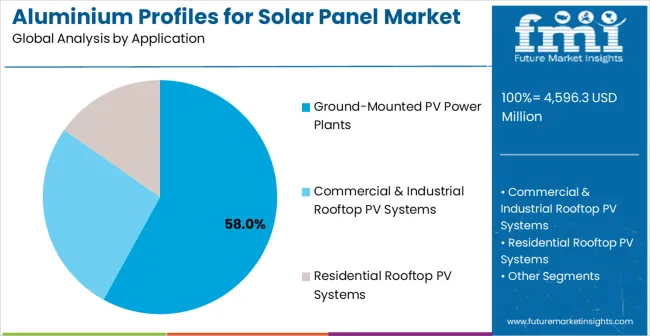
Ground-mounted PV power plants applications are projected to represent 58% market share of aluminium profiles for solar panel demand in 2025, underscoring their critical role as the primary application for structural aluminium components in utility-scale solar installations and large-scale renewable energy projects. Solar developers prefer aluminium profiles for their exceptional structural capabilities, installation efficiency, and ability to maintain consistent performance while supporting large-scale mounting requirements during utility solar construction. Positioned as essential materials for high-performance utility solar installations, aluminium profiles offer both structural reliability and installation efficiency advantages.
The segment is supported by continuous growth in utility-scale solar development and the growing availability of specialized mounting technologies that enable enhanced installation efficiency and system performance optimization at the project level. Additionally, solar developers are investing in advanced mounting technologies to support grid-scale renewable energy deployment and cost optimization. As utility-scale solar continues to expand and developers seek superior structural material solutions, ground-mounted PV power plant applications will continue to dominate the application landscape while supporting renewable energy advancement and grid integration strategies.
The aluminium profiles for the solar panel market are advancing steadily due to increasing renewable energy investments and growing demand for durable structural solutions that emphasize superior corrosion resistance across utility-scale and distributed solar applications. However, the market faces challenges, including aluminium price volatility affecting material costs, competition from alternative mounting materials, and supply chain constraints for specialized solar-grade alloys. Innovation in recycling technologies and sustainable manufacturing processes continues to influence market development and expansion patterns.
The growing adoption of aluminium profiles in floating solar and agrivoltaic applications is enabling solar manufacturers to develop mounting systems that provide distinctive environmental benefits while commanding premium positioning and enhanced application versatility. Advanced applications offer superior corrosion resistance while allowing more sophisticated solar deployment across various environmental categories and land use segments. Manufacturers are increasingly recognizing the competitive advantages of specialized mounting positioning for premium solar project development and innovative application market penetration.
Modern aluminium profile suppliers are incorporating recycling optimization technologies, sustainable production systems, and lifecycle assessment methodologies to enhance environmental performance, improve material efficiency, and meet industry demands for responsible and circular material solutions. These programs improve sustainability performance while enabling new applications, including high-recycled content profiles and carbon-neutral manufacturing processes. Advanced sustainability integration also allows suppliers to support premium market positioning and environmental leadership beyond traditional commodity aluminium products.
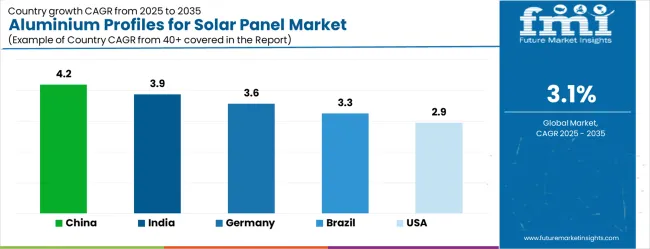
| Country | CAGR (2025-2035) |
|---|---|
| China | 4.2% |
| India | 3.9% |
| Germany | 3.6% |
| Brazil | 3.3% |
| U.S. | 2.9% |
| U.K. | 2.6% |
| Japan | 2.3% |
The aluminium profiles for the solar panel market are experiencing robust growth globally, with China leading at a 4.2% CAGR through 2035, driven by the rapidly expanding solar manufacturing sector, massive investments in renewable energy infrastructure, and increasing adoption of utility-scale solar technologies. India follows at 3.9%, supported by growing solar installations, rising renewable energy targets, and expanding manufacturing capabilities. Germany shows growth at 3.6%, emphasizing advanced solar technology and premium renewable energy systems. Brazil records 3.3%, focusing on emerging solar applications and renewable energy development. The U.S. demonstrates 2.9% growth, prioritizing clean energy infrastructure and solar manufacturing advancement. The U.K. exhibits 2.6% growth, supported by renewable energy development and advanced solar capabilities. Japan shows 2.3% growth, emphasizing precision manufacturing excellence and high-quality solar component production.
The report covers an in-depth analysis of 40+ countries top-performing countries are highlighted below.
Aluminium profiles for solar panels in China is projected to exhibit exceptional growth with a CAGR of 4.2% through 2035, driven by the rapidly expanding solar manufacturing sector and massive government investments in renewable energy infrastructure development across major industrial regions. The country's growing photovoltaic production capacity and increasing adoption of advanced solar technologies are creating substantial demand for high-quality aluminium structural components in both domestic installations and export manufacturing. Major aluminium manufacturers and solar component companies are establishing comprehensive production and processing capabilities to serve both domestic solar development and international export markets.
Aluminium profiles for solar panels in India is expanding at a CAGR of 3.9%, supported by growing solar installations, increasing renewable energy targets, and expanding manufacturing applications. The country's developing solar ecosystem and expanding renewable energy infrastructure are driving demand for reliable structural materials across both utility-scale and distributed solar applications. International aluminium companies and domestic manufacturers are establishing comprehensive distribution and production capabilities to address growing market demand for solar-grade aluminium solutions.
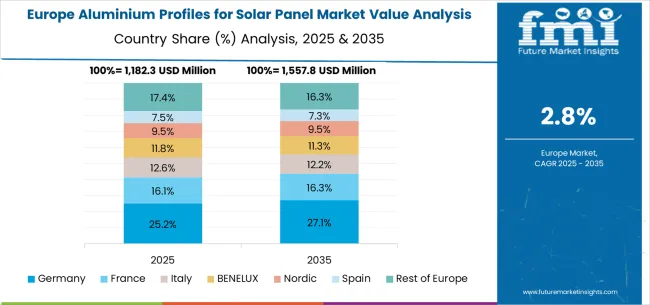
Aluminium profiles for solar panels in Germany is projected to grow at a CAGR of 3.6% through 2035, driven by the country's advanced solar technology sector, premium renewable energy capabilities, and leadership in sustainable energy solutions. Germany's sophisticated energy transition programs and willingness to invest in high-performance solar technologies are creating substantial demand for both standard and specialized aluminium profile varieties. Leading technology companies and renewable energy developers are establishing comprehensive innovation strategies to serve both European markets and growing international demand.
Revenue from aluminium profiles for solar panels in Brazil is projected to grow at a CAGR of 3.3% through 2035, supported by the country's expanding renewable energy sector, growing solar infrastructure applications, and increasing adoption of clean energy technologies requiring reliable structural solutions. Brazilian energy developers and international companies consistently seek durable aluminium materials that enhance system performance for both utility-scale and distributed generation markets. The country's position as a regional renewable energy hub continues to drive innovation in solar technology applications and energy standards.
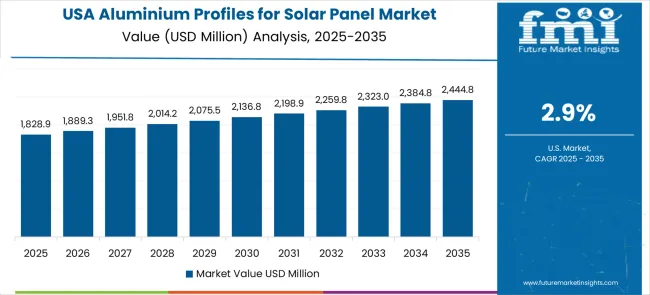
Revenue from aluminium profiles for solar panels in the United States is projected to grow at a CAGR of 2.9% through 2035, supported by the country's advanced clean energy sector, solar technology innovation capabilities, and established leadership in renewable energy solutions. American solar developers and manufacturing companies prioritize durability, performance, and sustainability, making aluminium profiles essential materials for both utility-scale installations and distributed generation projects. The country's comprehensive clean energy infrastructure and technical expertise support continued market development.
Revenue from aluminium profiles for solar panels in the United Kingdom is projected to grow at a CAGR of 2.6% through 2035, supported by the country's renewable energy development sector, advanced solar capabilities, and established expertise in clean energy solutions. British energy developers' focus on sustainability, performance, and energy security creates steady demand for reliable aluminium structural materials. The country's attention to net-zero commitments and renewable energy optimization drives consistent adoption across both utility-scale and distributed solar applications.
Revenue from aluminium profiles for solar panels in Japan is projected to grow at a CAGR of 2.3% through 2035, supported by the country's precision solar manufacturing excellence, advanced materials technology expertise, and established reputation for producing superior renewable energy components while working to enhance manufacturing efficiency capabilities and develop next-generation solar technologies. Japan's solar industry continues to benefit from its reputation for delivering high-quality energy materials while focusing on innovation and manufacturing precision.
The aluminium profiles for the solar panel market in Europe are projected to grow from USD 1,196.9 million in 2025 to USD 1,585.8 million by 2035, registering a CAGR of 2.9% over the forecast period. Germany is expected to maintain its leadership position with a 26.4% market share in 2025, remaining stable at 26.2% by 2035, supported by its advanced solar technology sector, precision renewable energy manufacturing industry, and comprehensive sustainability capabilities serving European and international markets.
The United Kingdom follows with a 16.8% share in 2025, projected to reach 17.0% by 2035, driven by renewable energy development programs, advanced solar capabilities, and growing focus on clean energy solutions for premium applications. France holds a 15.7% share in 2025, expected to maintain 15.5% by 2035, supported by energy transition demand and advanced renewable energy applications, but facing challenges from market competition and energy policy considerations. Italy commands a 13.9% share in 2025, projected to reach 14.1% by 2035, while Spain accounts for 12.3% in 2025, expected to reach 12.5% by 2035. The Netherlands maintains a 6.4% share in 2025, growing to 6.5% by 2035. The Rest of Europe region, including Nordic countries, Eastern Europe, Belgium, Switzerland, and Austria, is anticipated to hold 14.9% in 2025, declining slightly to 14.6% by 2035, attributed to mixed growth patterns with strong expansion in some renewable energy markets balanced by moderate growth in smaller countries implementing solar energy development programs.
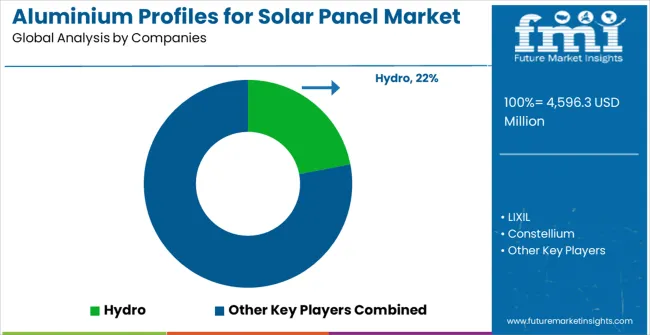
The aluminium profiles for the solar panel market are characterized by competition among established aluminium manufacturers, specialized solar component producers, and integrated renewable energy solution suppliers. Companies are investing in advanced alloy technologies, sustainable manufacturing systems, application-specific product development, and comprehensive technical support capabilities to deliver consistent, high-performance, and durable aluminium profile products. Innovation in material performance enhancement, sustainability advancement, and customized solar solutions is central to strengthening market position and customer satisfaction.
Hydro leads the market with a strong focus on sustainable aluminium innovation and comprehensive renewable energy solutions, offering sophisticated aluminium profile products that emphasize environmental responsibility and performance excellence. LIXIL provides integrated building materials capabilities with a focus on solar applications and global construction networks. Constellium delivers advanced aluminium technology with a focus on innovation and premium alloy development. Alumil specializes in aluminium systems and architectural solutions with emphasis on technical expertise and solar application optimization. Nanshan Aluminum focuses on aluminium processing technologies and advanced manufacturing systems. Xingfa Aluminium emphasizes aluminium profile expertise with a focus on solar applications and structural performance.
| Items | Values |
|---|---|
| Quantitative Units (2025) | USD 4,596.3 million |
| Alloy Series | 3XXX Series, 5XXX Series, 6XXX Series, 7XXX Series |
| Application | Ground-Mounted PV Power Plants, Commercial & Industrial Rooftop PV Systems, Residential Rooftop PV Systems |
| Regions Covered | North America, Europe, East Asia, South Asia & Pacific, Latin America, Middle East & Africa |
| Countries Covered | United States, Canada, United Kingdom, Germany, France, China, Japan, South Korea, India, Brazil, Australia and 40+ countries |
| Key Companies Profiled | Hydro, LIXIL, Constellium, Alumil, Nanshan Aluminum, Xingfa Aluminium, Galuminium Group, Minfa Aluminum, Xinbo Technology, Shanxi Bada, Anhui Shengxin Aluminium, Guangdong Hao Mei New Materials, and JMA Aluminum |
| Additional Attributes | Dollar sales by alloy series and application, regional demand trends, competitive landscape, technological advancements in alloy development, sustainability enhancement development initiatives, recycling optimization programs, and solar integration strategies |
North America
Europe
East Asia
South Asia & Pacific
Latin America
Middle East & Africa
The global non-terrestrial network solution market is estimated to be valued at USD 5,445.5 million in 2025.
The market size for the non-terrestrial network solution market is projected to reach USD 45,313.3 million by 2035.
The non-terrestrial network solution market is expected to grow at a 23.6% CAGR between 2025 and 2035.
The key product types in non-terrestrial network solution market are ntn-iot and ntn-nr.
In terms of application, commercial segment to command 68.0% share in the non-terrestrial network solution market in 2025.






Our Research Products

The "Full Research Suite" delivers actionable market intel, deep dives on markets or technologies, so clients act faster, cut risk, and unlock growth.

The Leaderboard benchmarks and ranks top vendors, classifying them as Established Leaders, Leading Challengers, or Disruptors & Challengers.

Locates where complements amplify value and substitutes erode it, forecasting net impact by horizon

We deliver granular, decision-grade intel: market sizing, 5-year forecasts, pricing, adoption, usage, revenue, and operational KPIs—plus competitor tracking, regulation, and value chains—across 60 countries broadly.

Spot the shifts before they hit your P&L. We track inflection points, adoption curves, pricing moves, and ecosystem plays to show where demand is heading, why it is changing, and what to do next across high-growth markets and disruptive tech

Real-time reads of user behavior. We track shifting priorities, perceptions of today’s and next-gen services, and provider experience, then pace how fast tech moves from trial to adoption, blending buyer, consumer, and channel inputs with social signals (#WhySwitch, #UX).

Partner with our analyst team to build a custom report designed around your business priorities. From analysing market trends to assessing competitors or crafting bespoke datasets, we tailor insights to your needs.
Supplier Intelligence
Discovery & Profiling
Capacity & Footprint
Performance & Risk
Compliance & Governance
Commercial Readiness
Who Supplies Whom
Scorecards & Shortlists
Playbooks & Docs
Category Intelligence
Definition & Scope
Demand & Use Cases
Cost Drivers
Market Structure
Supply Chain Map
Trade & Policy
Operating Norms
Deliverables
Buyer Intelligence
Account Basics
Spend & Scope
Procurement Model
Vendor Requirements
Terms & Policies
Entry Strategy
Pain Points & Triggers
Outputs
Pricing Analysis
Benchmarks
Trends
Should-Cost
Indexation
Landed Cost
Commercial Terms
Deliverables
Brand Analysis
Positioning & Value Prop
Share & Presence
Customer Evidence
Go-to-Market
Digital & Reputation
Compliance & Trust
KPIs & Gaps
Outputs
Full Research Suite comprises of:
Market outlook & trends analysis
Interviews & case studies
Strategic recommendations
Vendor profiles & capabilities analysis
5-year forecasts
8 regions and 60+ country-level data splits
Market segment data splits
12 months of continuous data updates
DELIVERED AS:
PDF EXCEL ONLINE
Aluminium Cladding System Market Size and Share Forecast Outlook 2025 to 2035
Aluminium Foil Zipper Pouch Market Size and Share Forecast Outlook 2025 to 2035
Aluminium Fishing Boat Market Size and Share Forecast Outlook 2025 to 2035
Aluminium Ammonium Sulphate Market Analysis – Size, Share, and Forecast Outlook 2025 to 2035
Aluminium Foil Seal Market Analysis - Size, Share, and Forecast Outlook 2025 to 2035
Aluminium Chloride Market Analysis - Size, Share & Forecast 2025 to 2035
Aluminium Market Analysis - Size, Share & Forecast 2025 to 2035
Aluminium-Free Deodorant Market Analysis - Trends, Growth & Forecast 2025 to 2035
Market Share Insights for Aluminium Bottle Providers
Competitive Landscape of Aluminium Foil Zipper Pouch Providers
Competitive Breakdown of Aluminium Cup Suppliers
Aluminium Cup Market Trends - Size, Growth & Demand 2025 to 2035
Aluminium Ion Battery Market Growth - Trends & Forecast 2025 to 2035
Aluminium Bottle Market Growth – Size, Demand & Forecast 2025 to 2035
Aluminium Foil Sachet Market
Aluminium Production Chemicals Market
Aluminium Nitride Market
Aluminium Composite Panels Market
USA Aluminium Bottle Market Insights – Demand, Size & Industry Trends 2025-2035
Japan Aluminium Bottle Market Insights – Growth, Demand & Trends 2025-2035

Thank you!
You will receive an email from our Business Development Manager. Please be sure to check your SPAM/JUNK folder too.
Chat With
MaRIA